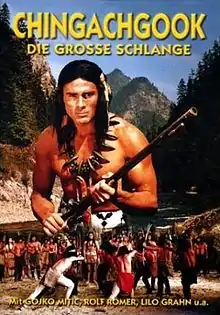Чингачгук
Чингачгу́к (по-делаварски: Chingachgook /xiŋɡaxˈgoːk/ Хингахго́к,[1][2] или xinkwi xkuk /xiŋɡwixˈkuːk/ «Хингуихку́к»,[3] Великий [Большой] Змей)[1][2][3] — герой ряда литературных произведений Фенимора Купера, принадлежит к литературному типу «благородный дикарь».
| Чингачгук | |
|---|---|
| Chingachgook | |
 Обложка DVD фильма «Чингачгук — Большой Змей», 1967 | |
| Создатель | Джеймс Фенимор Купер |
| Произведения |
«Зверобой, или Первая тропа войны» «Последний из могикан, или Повествование о 1757 годе» «Следопыт, или На берегах Онтарио» «Пионеры, или У истоков Саскуиханны» |
| Первое упоминание | «Пионеры, или У истоков Саскуиханны» |
| Пол | мужской |
| Дата рождения | вероятно 1726 |
| Дата смерти | 1793 |
| Семья | Уа-та-Уа (жена) |
| Дети | Ункас (сын) |
| Прозвище |
Большой змей Джон Могиканин |
| Род занятий | охотник, воин |
| Роль исполняет |
Бела Лугоши, Гойко Митич, Нед Ромеро, Джон Абинери, Георгий Пицхелаури, Рассел Минс, Родни Грант, Грэм Грин, Майк Брендел (Mike Brendel), Хосе Марко (José Marco) |
Происходит из племени североамериканских индейцев могикан. Чингачгук — мудрый и храбрый воин. Он добр и справедлив, его уважают друзья и боятся враги.
Вот что сказано в книге «Последний из могикан» о происхождении его имени:
«Конечно, имя Чингачгук, что значит „Великий Змей“, не означает, что он и в самом деле змея; нет, его имя говорит, что ему известны все извороты, все уголки человеческой природы, что он молчалив и умеет наносить своим недругам удары в такие мгновения, когда они совсем этого не ожидают»
Оригинальный текст (англ.)[показатьскрыть]“With an Indian ’tis a matter of conscience; what he calls himself, he generally is—not that Chingachgook, which signifies Big Sarpent, is really a snake, big or little; but that he understands the windings and turnings of human natur’, and is silent, and strikes his enemies when they least expect him.”
В книге «Последний из могикан» умирает его единственный сын — Ункас, последний из могикан, последний вождь и последний представитель некогда могущественного, но ныне считающегося вымершим племени.
См. также
Литература
- Дж. Купер «Зверобой, или Первая тропа войны» (1841).
- Дж. Купер «Последний из могикан, или Повествование о 1757 годе» (1826).
- Дж. Купер «Следопыт, или На берегах Онтарио» (1840).
- Дж. Купер «Пионеры, или У истоков Саскуиханны» (1823).
Образ в кино
- "Чингачгук - Большой Змей" (1967, ГДР, киностудия "ДЕФА", режиссер Рихард Грошопп, в гл.роли - Гойко Митич) [4];
- "Зверобой" (1990, СССР, "Союзтелефильм", режиссер Андрей Ростоцкий, в роли Чингачгука - Георгий Пицхелаури).
Примечания
- John Heckewelder, Letter XXVI from Mr. Heckewelder, Bethlehem, 10th October, 1816. In: John Gottlieb Ernestus Heckewelder, History, manners, and customs of the Indian nations who once inhabited Pennsylvania and the neighboring states. By the Rev. John Heckewelder, of Bethlehem, Pa. New and Revised Edition. With an Introduction and Notes by the Rev. William C. Reichel, of Bethlehem, Pa. Philadelphia: Historical Society of Pennsylvania, 1881. Part II. A Correspondence between the Rev. John Heckewelder of Bethlehem, and Peter S. Duponceau, Esq., corresponding secretary of the Historical and Literary Committee of the American Philosophical Society, respecting the Languages of the American Indians. (pp. 349—433), p. 431, Chingachgook, a large snake.
- William A. Starna (1979), Cooper’s Indians: A Critique (SUNY Oneonta). Presented at the 2nd Cooper Seminar, James Fenimore Cooper: His Country and His Art at the State University of New York College at Oneonta, July, 1979. Originally published in: James Fenimore Cooper: His Country and His Art, Papers from the 1979 Conference at State University College of New York, Oneonta and Cooperstown. George A. Test, editor. (pp. 63-76). Cooper took the term directly from Heckewelder. However, it has been pronounced incorrectly since its appearance in Cooper’s works. It is pronounced properly "chingachgook, " the ch- in initial position resembling a gutteral «h» («hing'»). Heckewelder, a German, rendered the spelling as Cooper wrote it, but the pronunciation would be as in Heckewelder’s native language.
- Delaware Tribe od Indians, Lenape Talking Dictionary: English: big snake, Lenape: xinkwi xkuk Архивировано 2 декабря 2013 года..
- Настоящий Чингачгук // Коммерсантъ.